-
Posts
3,632 -
Joined
-
Last visited
-
Days Won
36
Content Type
Profiles
Forums
Blogs
Gallery
Posts posted by Hawkeye
-
-
Hi Adam,
no problem to send you a spare LED, with all the "Murphy's Law" you encountered during the build!
But, could you count if you don't have a spare already? For similar reasons (i.e. if one of the LEDs is defective from the start or is damaged during installation), we usually pack a total of 60pcs 2x3x4mm LEDs for a full kit, so there should be more than a single white 2x3x4mm LED left over as a spare.
Have a good sunday and best regards,
Peter -
And, it's finally release-day, sorry for all the delays and thanks to everyone who helped!

The LoopA is now publicly available in two variants, a caseless/barebones variant, and an acrylic case variant:https://www.midiphy.com/en/shop-details/139/69/caseless-loopa-essential-kit
https://www.midiphy.com/en/shop-details/139/65/loopa-acrylic-case-essential-kitAlso, Adrian Hallik from Hallik Engineering is working on a new metal case, which should be available in early 2020. You can easily transplant the caseless LoopA to any case.
Here is the full (2 hours +) video tutorial, all in all it should be a doable project and there are no IDC cables to build! :)
And here are some impressions/photos of the kits and the final units - enjoy! :)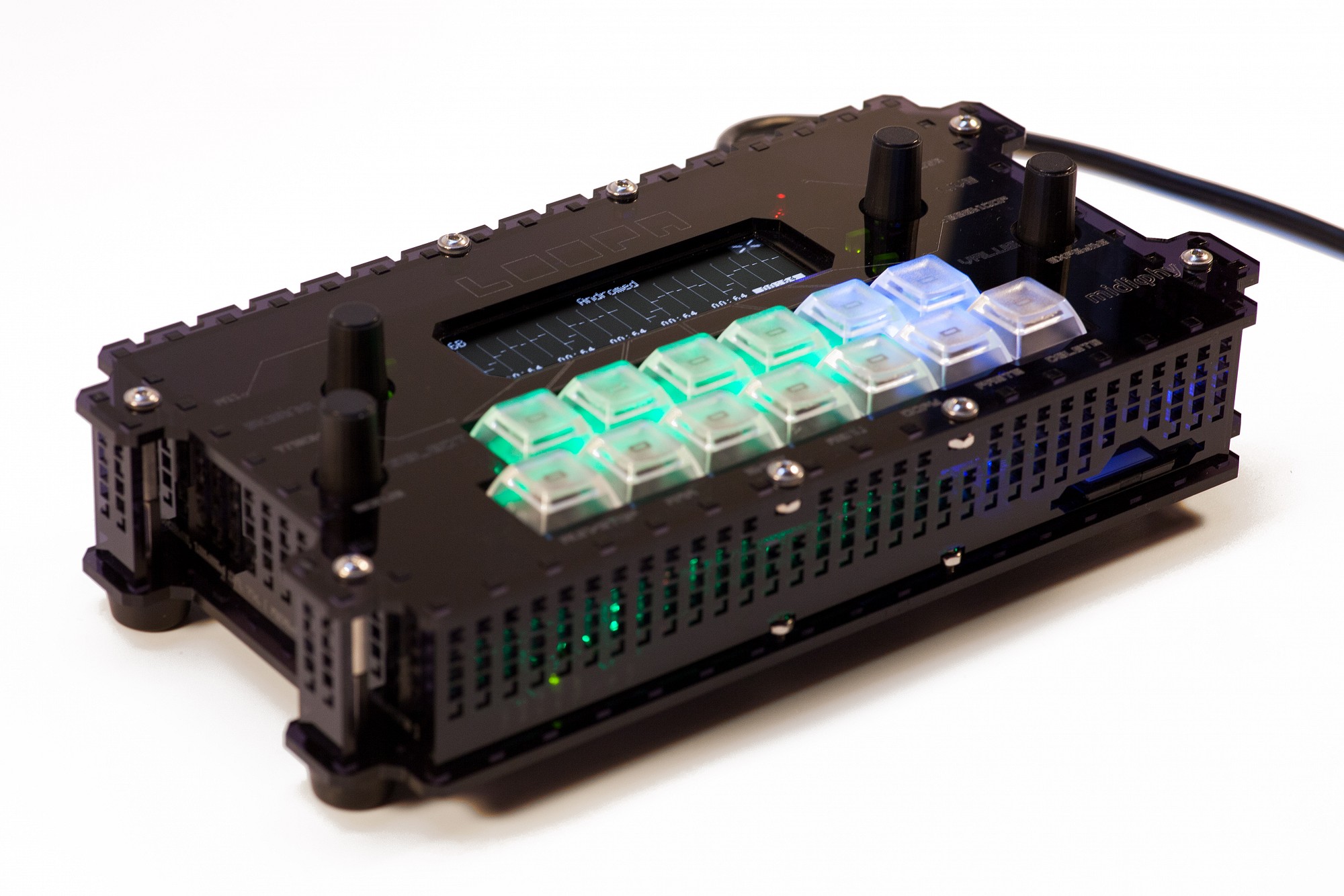
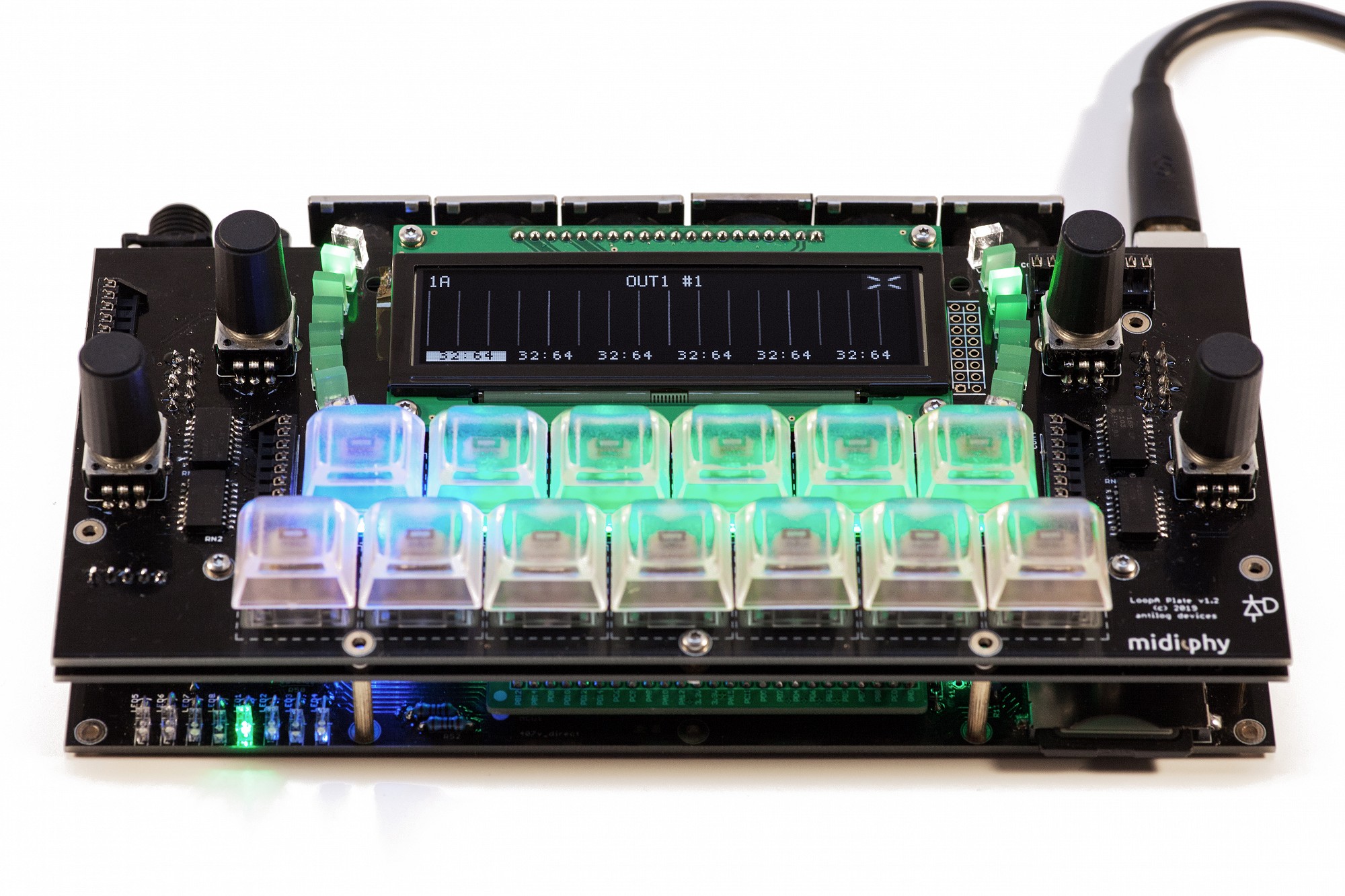
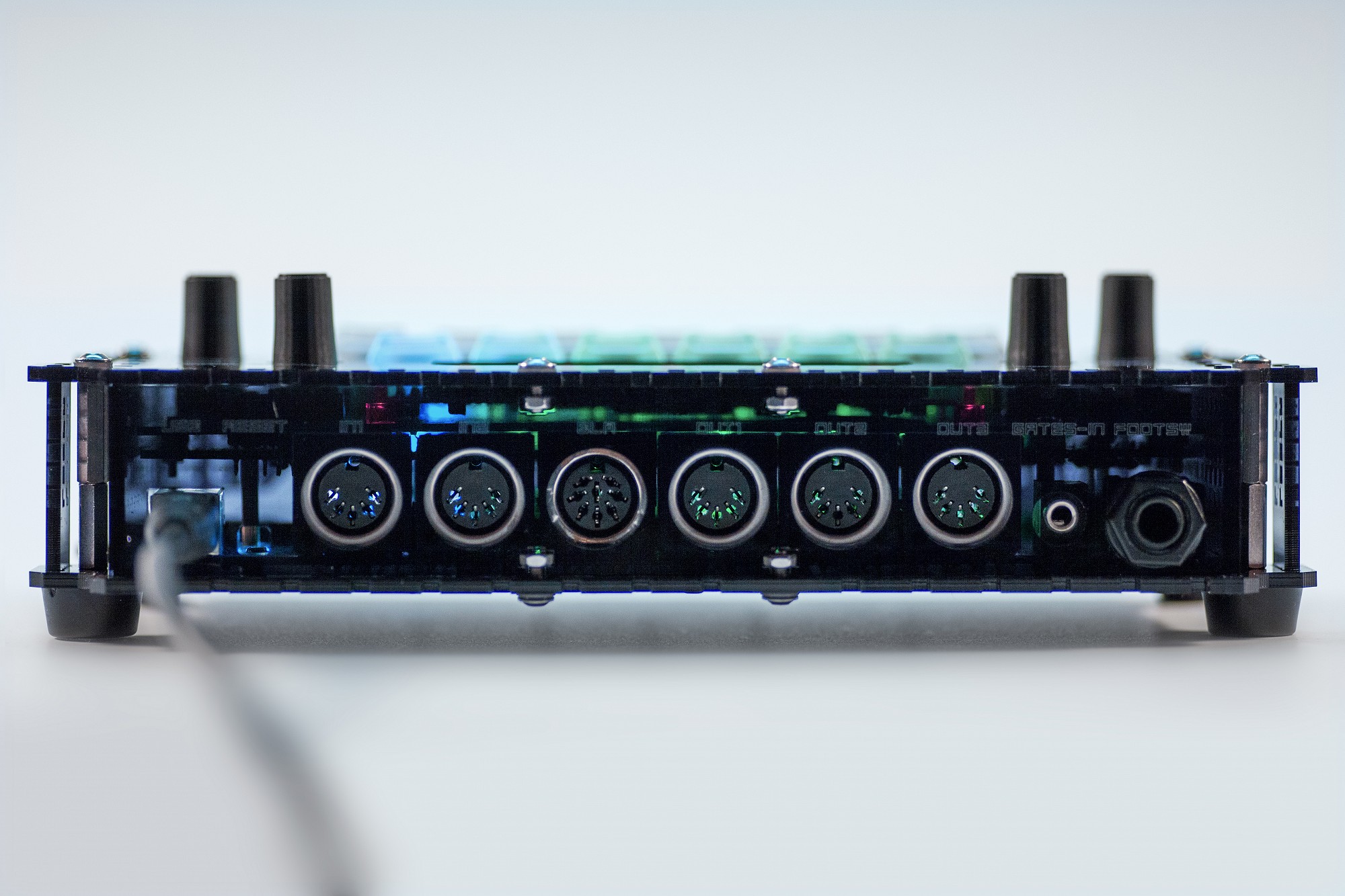
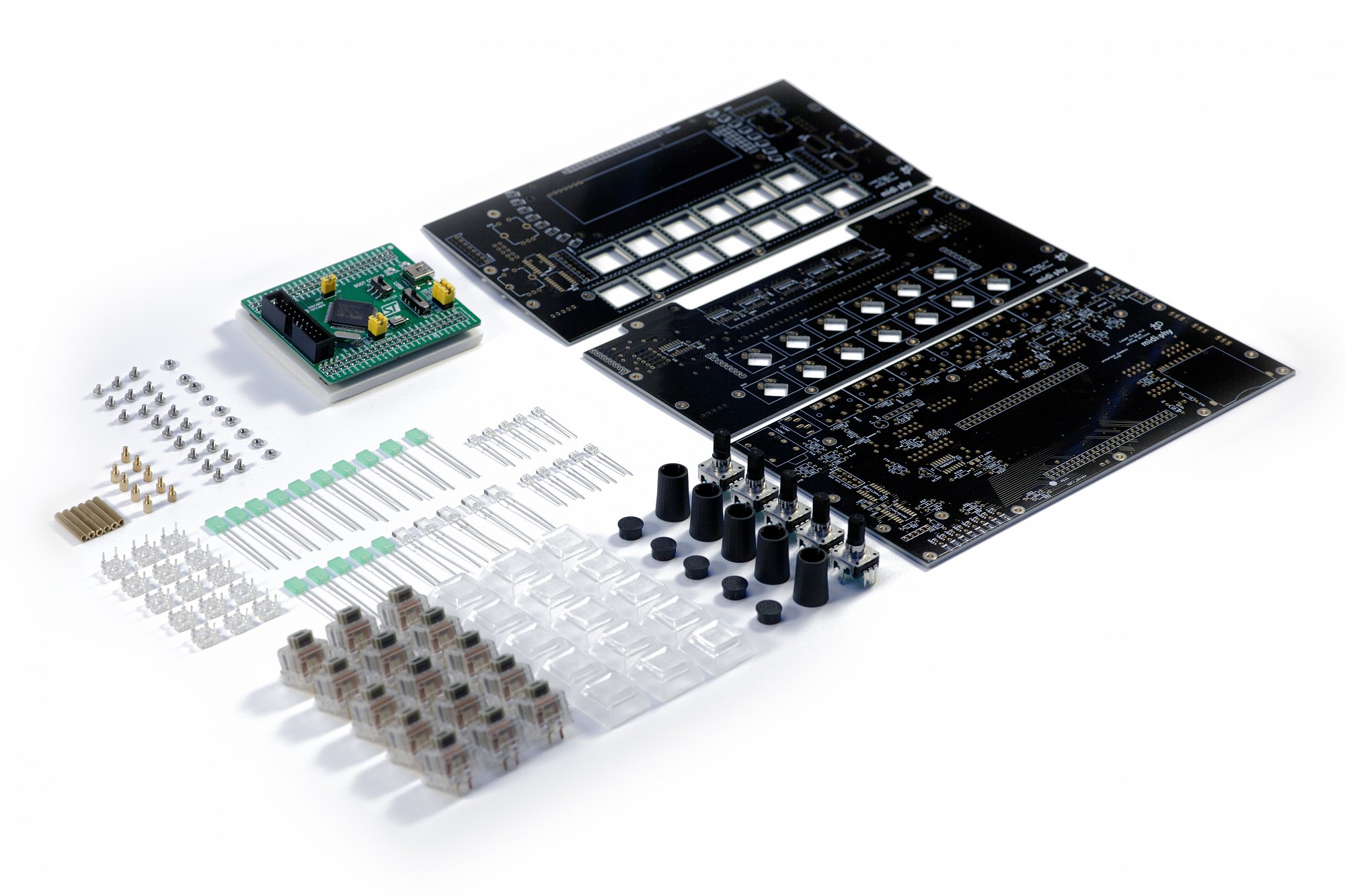
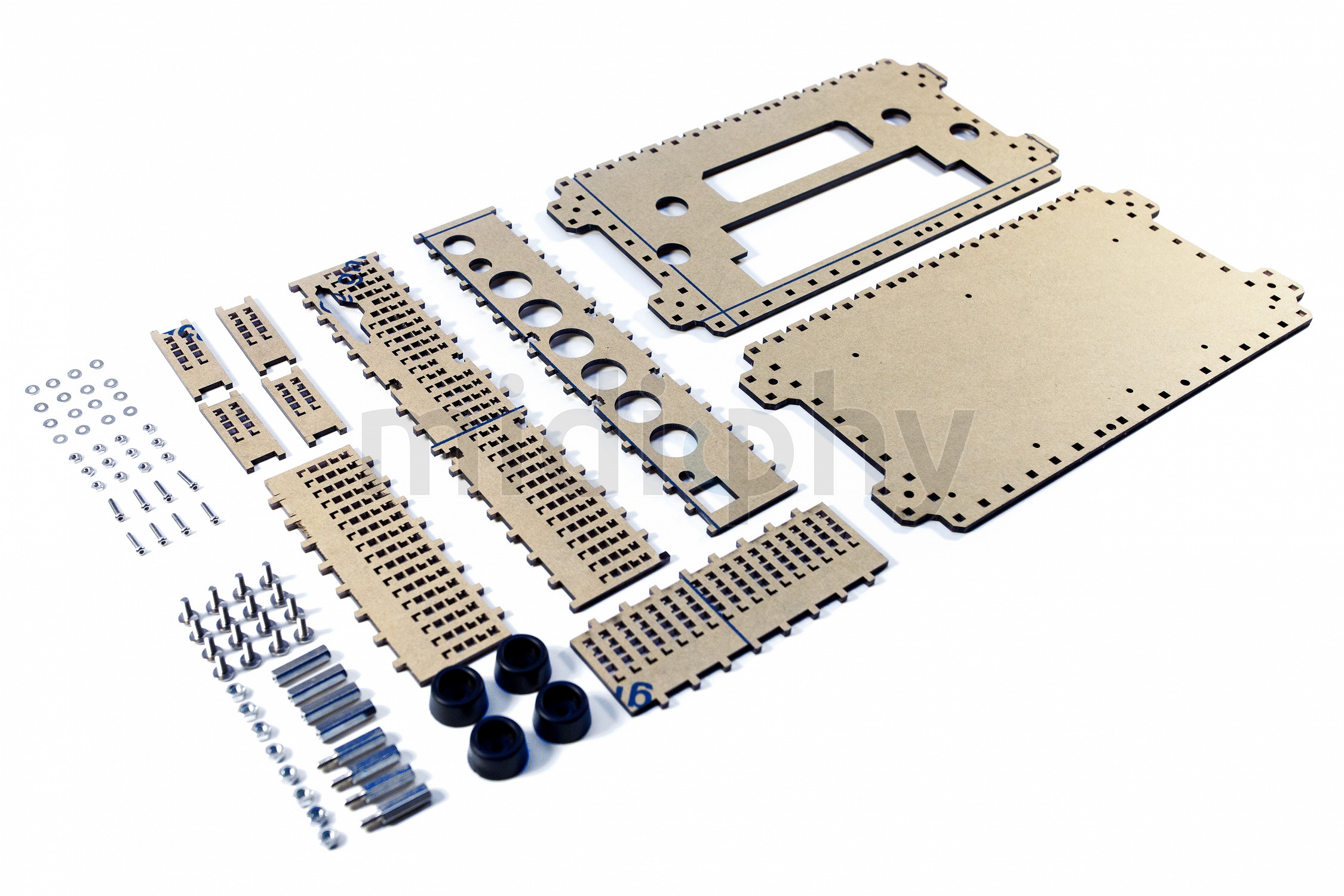
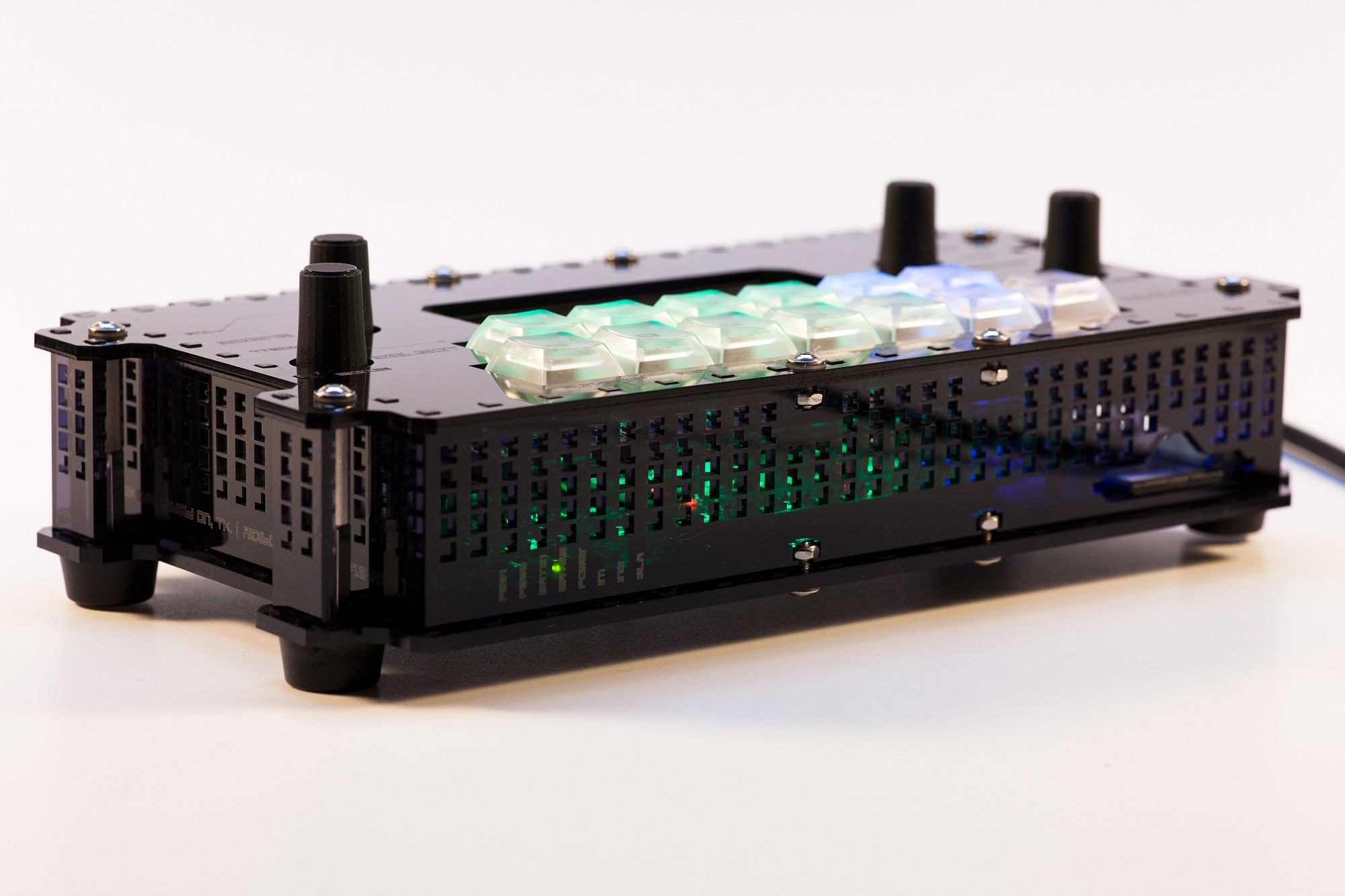
Firmware releases and user manual/handbook documentation updates will always be posted/linked in the first posting/on top of this thread!
Have a great weekend and hope you enjoy the LoopA!
Best regards,
Peter -
Probably it's best to keep the personal discussion in private via PM, no public fighting please.
Will lock it for now, can be reopened if requested and if nonpersonal technical/legal discussion continues.
Have a good weekend, it's a hobby, take it easy! :)
Best regards,
Peter -
Please define "open" - anything that has been released in the recent decade or so, is based on TK.'s designs. This ecosystem, the MIDIbox hardware platform is fully documented, with free schematics and there is full source code available, everything is free for personal usecases. That's an awesome gift from TK. to the world!
"Manufacturers" like Wilba/SmashTV, now sold via modularaddict.com or midiphy.com have just added a few bells and whistles to TK.'s ideas, like some fancy OLEDs or just added nice cases - but the base, the ecosystem is always the same, the modular, fully documented MIDIbox hardware platform. As "product development" takes time, effort and money, these manufacturers usually opt to protect their investment by not fully releasing e.g. CNC case plans or gerbers. These "products" are ok'ed by TK. for the reason, that a broader base of users can have access to the MIDIbox platform. Otherwise, creating everything from scratch will take time. E.g. i've built my first SEQ v4 completely from scratch in 2010, back then i had the time for it and it was an awesome experience (it's even documented somewhere in the forums with a photo tutorial, search for "ebony seq v4"). But not everyone wants to do that, or has the time for it.
So, to answer your question: assume everything listed on ucapps.de is released under a "free for personal use license", everything sold commercially has to have been "ok'ed" by TK. before and those products do not automatically inherit full disclosure obligations of every file needed to create the product. If a "vendor" asks TK., if it is ok to release a MIDIbox-based product commercially, TK. will always ask for guaranteed customer support and probably look for a good track record in the forums of the respective creator over some years.
Speaking for midiphy - in your own project, if you ever plan to use any unclear feature of our products, e.g. how the superflux LEDs are controlled, how the activity matrix is driven, or what is necessary for noiseless OLED operation, just ask the respective questions in the forums and i am sure you'll get technical and detailed answers.Best regards and have fun creating!
Peter -
@Corwin Probably all has been said now, there should be need to escalate things further, that is, if you, as the original poster are not out for an escalation?
Of course, this is highly subjective, but as a personal sidenote, I don't see how "open source", "free for personal, non-commercial use" could be enhanced any further without adding pages of useless legal smallprint, that does not really add any more information?
You're here to create a new personal project?
Absolutely awesome! Welcome to the forums! If you want and have the time, please share your ideas, create a new thread for discussion with others. Feel free to use and enhance the available software in any way that is required for your project, it is all good.Have a good friday and a nice weekend!
Peter -
The software license is documented here:
Software Architecture
Open-Source: yes(completely)
License: Personal, non-commercial use only---
So, in short words, you can use MIOS for personal non-commercial projects at any time, you have full open source software access via github.
If you are planning to sell anything (hardware or software), just ask TK. - it's not super complicated.Have a good day and best regards!
Peter -
What are you looking for exactly?
The midiphy schematics are not publicly available, these are only handed out to customers, if required, which is similar to what Wilba's did when he was actively designing PCBs.
Usually, the schematics would be required to find and fix a build problem, but these problems are most often and more easily found and corrected by direct support, which is mostly done by latigid on. If i recall it correctly, there is not a single SEQ v4+ that was not completed due to a tech question.
If you want to start scratch-building a new sequencer, really, ucapps.de has the best documentation out there, that you can think of.
Best regards!
Peter -
It's all documented in here, including the proper hwcfg reference - Modularaddict sells the Wilba boards.
Have fun with your new SEQ V4 and have a nice upcoming weekend!
Peter -
The source code is available on github: https://github.com/midibox/mios32
The schematics are available on ucapps.de and on wiki.midibox.org - this should get you going DIYing a CV sequencer from scratch.Have fun and have a nice upcoming weekend!
Peter -
With these "symptoms", it's most likely not the encoder pins not being crossed (but they should be, if you are using e.g. ALPS STEC12, @norbim1 found this out some years ago, thanks again!).
If the pins are not crossed, i only sometimes saw some slightly erratic encoder control, e.g. the cursor sometimes jumping two steps instead of one, when scrolling, but one could use the unit without big problems.With this issue, i'd suspect a problem on the DIN side, check the 74HC165 shift registers and their respective pullup resistors/resistor networks. If the screen freezes up, make also sure you are feeding it the correct voltage (5V/3V3 jumper) and that your 5V PSU power rail is sufficiently stable, i've seen very cheap USB "phone charger" PSUs that would cause displays going scrambled, either they were overloaded from the beginning or they produced a lot of switcher noise on outputs.
Good luck and many greets!
Peter -
Another update - filming and video editing of the LoopA construction video tutorial is completed, all is looking good, we should be able to release the LoopA right in time before the holiday season! :)
Here is a new LoopA demo video, this time concentrating on a few of the new "launch version" features, most notably beatloop and live transposition of selectable tracks:
The demo is not at all focussed on musical finesse :), but to show some of the new features integrated in the launch software version of the LoopA.
In the beginning of the track, the LoopA is launched with "Beatloop" mode active, a new non-linear time progression model, which has different modes. Some modes scan the sequence while retaining an identical sequence playback time. It is great to create new melodic progressions while retaining harmonies and is also interesting for scrambling up recorded drumloops.
Later on, we explore some "live transposition" features, where multiple selectable tracks (e.g. to exclude drum tracks) are transposed via a single live encoder action. Live transposition is measure-synchronized to occur "always just in time".
Also, scene progression is fully synchronized to the recorded loops, so you can confidently proceed to a new scene at any time in your performance.
The LoopA is inteded to be used as a "musical note pad" or an "idea generator", it has been designed to be easy to use and has different features than its bigger 16-track brother, the SEQ v4+. Depending on your musical style, it should normally be easily able to hold a whole song in a session, which contains up to 36 looped note clips (these are arranged in 6 tracks x 6 scenes). Sessions are fully storable and recallable on/from a removable SD card within seconds.
Hope you enjoyed the demo - and thanks for watching and listening!
Many greets,
Peter -
Happy Birthday, TK.!
Hope you enjoy the day and find some time for a few nice bavarian beverages! :)

Many greets!
Peter -
Thanks, Altitude and Bruno!
Bruno: used an own version of the screenshot tool, exporting to PNM files, but thanks for sending the code anyways :)
Now, on to some more video editing :)Have a good evening!
Peter -
Update! :)
Well, it has certainly taken a while, but the LoopA release should really be happening soon, now! The assembly video tutorial has been completely filmed (350 GB of 4k footage), and now "just" needs video editing and voiceover. The PCBs have been built a third time and the BOMs are now verified. Also, the launch software version 2.05 has been tested, tested again and then completed :).
Many thanks to Andy for the huge amount of time he invested in this, from creating the PCBs to endless dicussions to finally proofreading the manual!
And here it is - we've finished the LoopA user manual, describing all features and screens in 20+ pages, so you can have a glance what the unit will do - we hope you will like it:
https://www.midiphy.com/files/468/midiphy_LoopA_manual_v205.pdf
Of course, there are lots of future features/enhancements on the wishlist, but the current features will be "it" for the launch and we hope you also consider them to be nice! :)
An (incomplete) list of new things since the last update:
* named user instruments mapping to hardware MIDI ports/channels (e.g. you can now simply use "ANDROMED" instead of memorizing MIDI OUT1/CHN1)
* a detailed setup page, allowing to configure global parameters
* a new and optimized page switching UI, using a onehanded two-finger-gesture facilitating "haptic finger memory" for quick page switching
* fully graphical menu/page icons
* a dedicated shift button, allowing for direct mutes/unmutes from every menu screen (an often needed feature)
* two powerful live performance modes (beatloop/transpose), switchable and directly mapped to a separate performance encoder
* MIDI metronome support
* live (re)quantized swing
* note randomization/probabilities (visualized als "animated quantum note clouds" if the clip notes playback probability is less than 100% :))
* note freezing option after transformations (allows e.g. to "move" notes around a clip first, freeze and then "scale" their playback speed)
* integrated context-sensitive help system explaining every feature of every screen... and a few others :)
Hope you enjoy! Please stay tuned, more coming soon!
Best regards,
Peter -
Hi Adam,
first of all, thanks for your intensive testing, you would not want to test the new LoopA boards, too by chance? These should be ready soon :)
Then, I checked all LeMEC_Rs we have in stock (new ENIG plated are a newer version than the 1.3_Rs) and a handful of remaining HASL ones with the same version 1.3 we still had as old stock - no problem on a few dozen totally tested boards, so it must be a local thing on your board, i'd expect a scratch, or a lifted/misconnecting pad or something like that. Also, the 1.3s were built by many people without that problem.
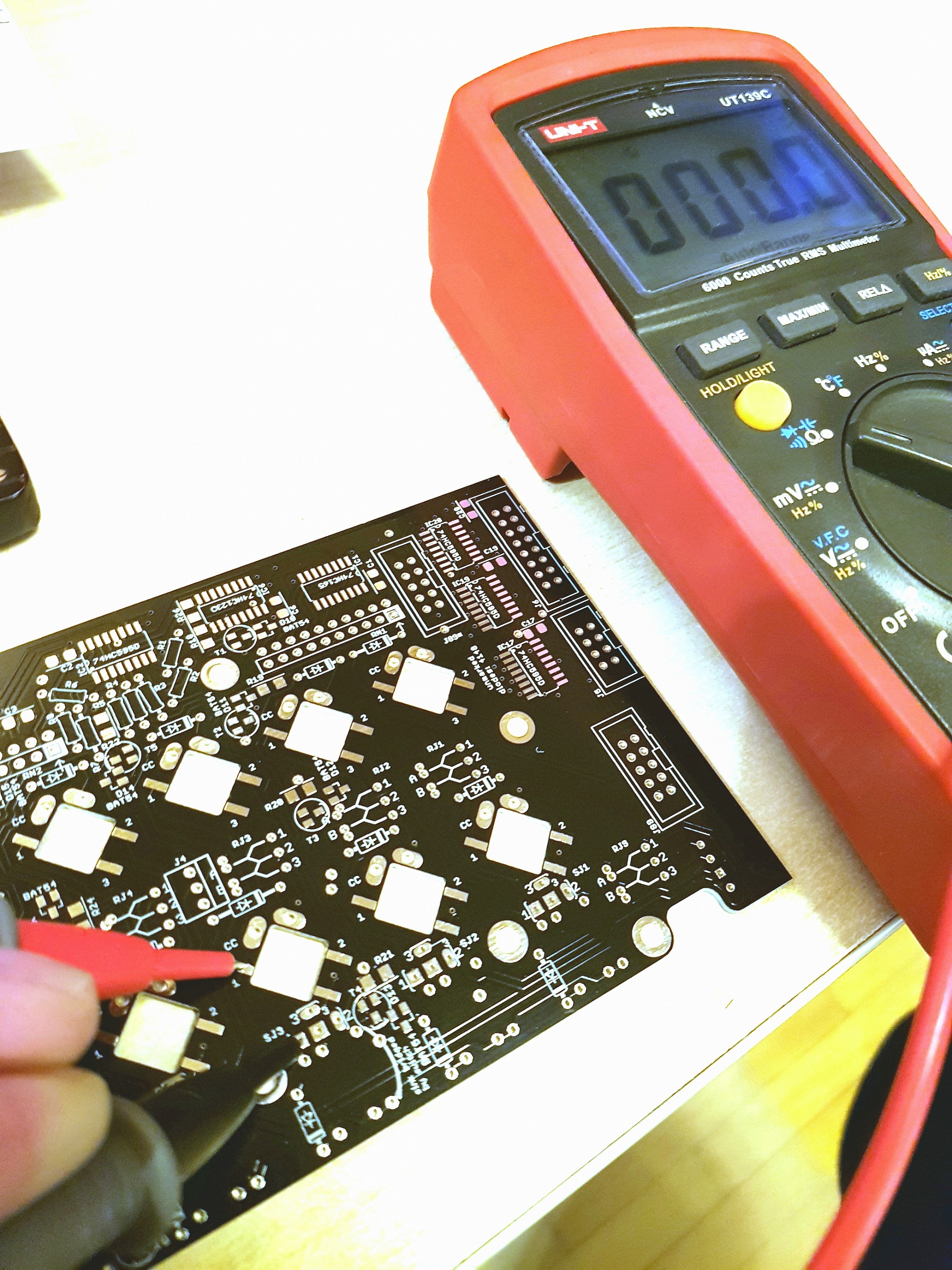
Here is how i measured - PIN 1 lower superflux (red) to PIN 1 SJ connector - and i just heard a lot of beeps for many boards :) - the one in the picture is a 1.3_R.
We take all quality reports seriously and if you say it's a problem on the PCB, we'll send you a new board as a replacement, i just could not reproduce it on any of the boards we have in stock.
Best regards,
Peter -
Yes, very good! Well done!
Many greets, Peter
-
Nice one, but he could have cleaned his fingernails! ;-)
-
Got to check the arp settings on my MB6582 - but in general they should work. Which firmware version do you have installed? (Should be shown on bootup).
Regarding SIDs - yes, two SIDs are required for stereo output, there should be some nice patches where different PWM modulation is put on the L/R channels, so you can hear a subtle difference between them. Perform a filter sweep to see if the filters work on both left and right channels - then both your SIDs are confirmed working - the LEDs only indicate assumed output, you've got to listen to the unit's outputs to make sure that e.g. the SID filters are not broken.
If you need more output channels, you can use the Multi Engine (just init the patch that way), then you've got 6 instruments of pure SID joy (hard panned left/right)! :)
Many greets and enjoy!
Peter -
@studio nebula maybe for your peace of mind :) - before we launched the v4+, i tested my first batch of LeMEC boards for a full week, 7x24 hours using only 10R resistors all around! No single LED failed :). The 1/8th duty cycle probably made that happen - and at fairly quick duty cycle rates we probably are looking at average current rather than peak current, if we have a good heat sinking solution, which is given for those superfluxes. The average current would only something like 60mA divided by eight when you use a 47R for red. Nevertheless Andy since then has given me the title equivalent of "mad LED slayer" or such, could not decipher the word he used, hehe :). Note also that brightness did not increase much more when going down from 22R to 10R, the LED is just saturated and the long cycle-off time and the big internal superflux heatsink material will probably keep it from burning up.
I doubt that you can kill it with a 47R even with disabling the matrix. But i think you will be really safe with 100R resistors all around, but i would not worry too much, in doubt the superfluxes can be easily replaced, as they are accessible from the backside. But never had to do it yet.
Have a great new week start!
Many greets, Peter -
Yes, agreed, a power supply issue might explain it (also back then for my old V4) - @Rio: do you have access to a scope and could monitor the 3V/5V supply lines during unit startup? This might also explain why problems don't happen with low-speed cards, as the transfer speeds or card response speeds might be limited and not pushing the system that much?
Many greets,
Peter -
In the case of my old V4, it was almost certainly questionworthy wiring of the SD card attached to a too long ribbon wire - and general noise introduced by VFDs, long wires and no buffering anywhere :). I don't think the schems have changed dramatically, but Thorsten or Andy may know more.
Many greets, Peter
-
@Rio just as a confirmation, i sometimes had this problem, too on my old SEQ V4 (not the new v4+) and it occured just at power up time. Once the startup was successful and the SD card could be read, it did not happen again during runtime. I suspect the SD card cable might have been a bit too long, or maybe it was caused an unstable power supply. After upgrading to the new v4+ (with the shorter cable within the case) i never experienced this problem again - and i am using the same physical SD card as before, unchanged since 2010 or so :).
Best regards!
Peter -
@Smithy also, your MBSID drum demo still beats all of my youtube videos regarding views! :)
Bad friend! :)
Hehe!
Many greets, Peter -
@TK. thanks a lot for your quick answer! We're discussing it!
Many greets, Peter



LoopA V2 Introduction, Features & Support Thread
in MIDIbox User Projects
Posted
Thanks Bruno and Altitude! :)
Altitude, will send you the acrylic case display cutout dimensions via PM or email shortly.
Best regards and have a nice sunday!
Peter